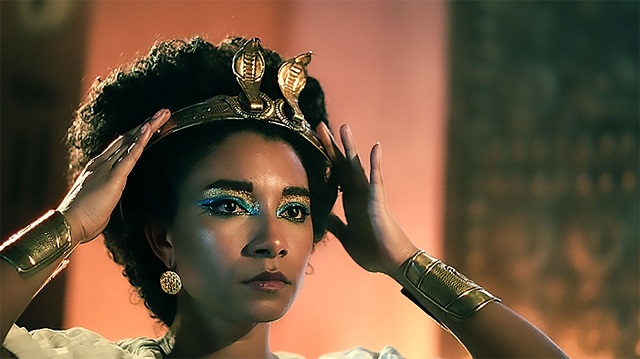
Netflix’s Queen Cleopatra has revived a century-old controversy
Kampala, Uganda | THE INDEPENDENT | “I announce on this day to the media that Cleopatra was not black. Cleopatra was Greek, similar to the queens and princesses of Macedonia. If we look at the scenes in the Egyptian temples, we can see that the pharaohs are depicted and in front of them were Nubian, Libyan, and Asian captives, the king is always completely different from all of them.
“I am not against black people at all, but here I am just listing the evidence that Cleopatra was not black,” renowned Egyptian archaeologist and former Minister of Antiques, Zahi Hawass, wrote on his Facebook page after the official trailer to the Netflix film ‘Queen Cleopatra’, was shared online.
The film, produced by Jada Pinkett Smith and starring British actor Adele James as Queen Cleopatra, was released on May 10 as the second in a Netflix “docuseries” on African queens, focusing on female rulers from the African continent.
This film sparked outrage in Egypt.
Some Egyptians complained that the feature appropriated their culture and rewrote their history. Social media hashtags and online petitions to ban the film started, and the Egyptian government released a statement and images of historical depictions of the queen, refuting the idea that Cleopatra was black.
“I am against the film because it is pushing an Afrocentric agenda, regardless of the historical accuracy of whether Cleopatra was Black or White,” Egyptian archaeologist Monica Hanna told CBS News.
Cleopatra, a member of the Ptolemaic dynasty, traced her ancestry back to its founder, Ptolemy I Soter. The Ptolemies, the final dynasty of the Egyptian pharaohs, were from Macedonia, a powerful state on the edge of what is now known as Ancient Greece. Macedonia is the birthplace of Alexander the Great, who conquered Egypt in 332 BC.
In the power struggle after Alexander’s death, one of his most powerful generals, Ptolemy, proclaimed himself Pharaoh. His descendants ruled there for the next three centuries, and Cleopatra was the last of this dynasty. She succeeded her father, Ptolemy XII, in 51 BC and ruled until she died in 30 BC. But no-one actually knows what Cleopatra looked like as the ethnic origin of her mother remains unclear.
This is not the first time the portrayal of Cleopatra has caused controversy. Two and a half years ago, there was also heated debate when it was revealed that Israeli actress Gal Godot would star as Cleopatra in an upcoming movie. And when Elizabeth Taylor played the leading role in the Oscar-winning 1963 film “Cleopatra,” her portrayal of the Egyptian Pharaoh was not widely accepted, as critics suggested a performer of colour would have been better in the role.
And while casting an Arab actress rather than a Black actress wouldn’t be creatively problematic, it would be historically inaccurate, as Arab colonisation of Egypt began many decades after Cleopatra died.
In a statement to Tudum, Netflix’s editorial website, Queen Cleopatra producers said: “her ethnicity is not the focus of Queen Cleopatra, but we did intentionally decide to depict her of mixed ethnicity to reflect theories about Cleopatra’s possible Egyptian ancestry and the multicultural nature of ancient Egypt.”
This controversy has also revived a century-old question: Were the ancient Egyptians Black?
When Black Egypt was commonplace
There was a time when Western scholars voiced the Black Egypt thesis, which remained dominant until the early 19th century.
The Greek historian and geographer Herodotus, who had travelled and stayed in ancient Egypt for years in the 6th century BC, compares the Egyptians, by their physical characteristics, to the Colchians and Ethiopians.
In the 18th century, the French aristocrat and traveler Count Volney travelled to Egypt and the Middle East. And after seeing age-old monuments and temples lying half-buried in the sand in Egypt, he wrote in his book ‘Ruins of Empires’:
“How is it, a people, now forgotten, discovered, while others were yet barbarians, the elements of the arts and the sciences? A race of men now rejected from society for their sable skin and frizzled hair, founded on the study of the laws of nature, those civil and religious systems which still govern the universe.”
Volney’s conclusions were a direct challenge to the theory of race hierarchy, which constituted the moral and ideological justification of slavery. If ancient Egypt was Black, then Africans couldn’t be considered an inferior race, and Europe’s “mission” to “elevate” Africans to “civilisation” through slavery was doomed. This evidence of Egypt required a radical restructuring.
Then came… the Caucasian Egypt thesis
From the late 18th to early 19th century, European academic circles increasingly advocated for the thesis of a Caucasian Egypt, which soon became the official truth. This was supported by the Arab population of Egypt following the Arab conquests. The Muslim conquest of Egypt, led by the army of Amr ibn al-As, took place between 639 and 646 AD. Egypt then became a province of the Byzantine Empire, ruled by a governor residing in Alexandria. The region fell under Ottoman rule after the fall of the Byzantine Empire in 1450.
In the golden age of slavery and colonisation, Western Egyptology tended to align not with scientific rationality but with the notion of racial hierarchy that considered the white man a superior race and black people as an inferior race.

European scholars opposed Volney’s comments as simply inadmissible. The German school led the movement, advancing a theory of a “Mediterranean race” coming from Western Asia, or a Semitic people, to classify the Egyptians.
“Racism has historically flourished through Egyptology, as Western Egyptologists always supported the thesis of a White Egypt to comfort racist theories”, Cameroonian historian Nkogueh Balog told bird Story Agency.
One of the most famous supporters of “Caucasian Egypt” was the English-born American Egyptologist George Robin Gliddon. In the 1840s, he held well-attended conferences across the USA, where he exhibited mummies.
“In this man’s skull, we see one of our own, a Caucasian, a pure white man, despite the bitumen that has blackened his skin,” he said.
The Comeback of Black Egypt
The Black Egypt thesis had been prevalent in the USA anti-slavery and abolitionist circles in the 19th century.
In the 20th century, the thesis for a Black Egypt found its contemporary and more powerful expression through the works of Senegalese historian Cheikh Anta Diop. In 1954, Diop released his milestone book, Nations nègres et culture (Negro Nations and Culture).
He believed ancient Egypt was an African civilisation, not a Middle East civilisation, as mainstream Egyptologists alleged. He also emphasised that it was rooted in an African culture that still exists today in what is called sub-Saharan Africa.
Diop demonstrated the many similarities between languages and customs throughout the African continent and those of ancient Egypt. He unveiled ancient and silenced testimonies in which the Egyptians described themselves as black people and referred to the land of Punt (part of today’s Somalia and Kenya) as the country of their ancestors.
He challenged the description of ancient Egyptians as a “dark red” or “Mediterranean” race. Diop pointed out that many African peoples have a reddish-brown complexion, including the modern-day Maasai of Kenya.
He also highlighted comments left by the Greek writers of antiquity who highlighted the resemblance between the Egyptians and the Ethiopians. Diop’s works found powerful international support and set the stage for a total rethinking of Africa’s historiography.
Since then, the notion that the ancient people of Egypt were an African civilisation has become broadly accepted.
And yet, skin colour remains a bone of contention. Generally speaking, while African scholars and academics adhere to the idea of black-skinned ancient Egyptians thesis, their Western and Arab colleagues adhere to one of a Middle Eastern, light-skinned people.
It is challenging to pinpoint the exact origins of Egyptian civilisation. Ruled by Nubians for nearly 100 years and with a kingdom and trade routes that extended far south into the rest of Africa, as well as east and west, the people of ancient Egypt came from different parts of Africa and neighbouring regions, creating a cultural melting pot with multiple ethnic groups, and a complex history.
Any mainstream movie or documentary representing Cleopatra as black or white will inevitably spark debate and nurture controversy.
******
Source: bird story agency
 The Independent Uganda: You get the Truth we Pay the Price
The Independent Uganda: You get the Truth we Pay the Price




This is wrong and complete misinformation and based on chosen scholars that’s support the africentiric agenda the origin of the Egyptians is the Levant as backed up in many DNA studies, no Nubian was ever found in any elite burial in any part of Egypt. They were part of a caucasoid group that occupied north Africa 20000 years ago. The only time a black man ruled Egypt was in the 25th dyn when kush invaded and they only ruled for approx 60 years. Then all Nubians were expelled this was the begining of the new kingdom and none were allowed to enter Egypt until after the empire fell. Your article is utter garbage and spreading racially divisive lies